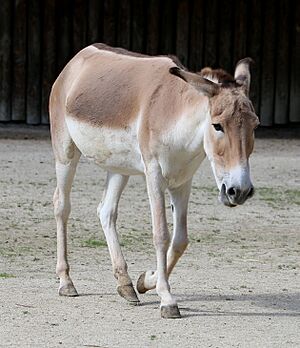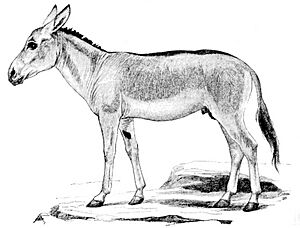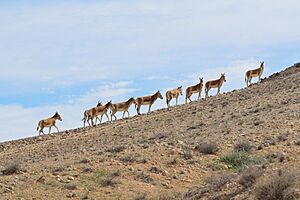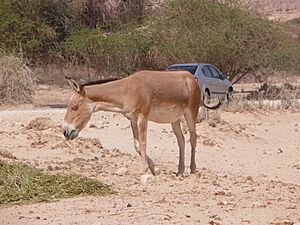Persian onager facts for kids
Quick facts for kids Persian onager |
|
|---|---|
 |
|
| Persian onager at Augsburg Zoo, Germany | |
| Conservation status | |
| Scientific classification |
|
| Kingdom: | Animalia |
| Phylum: | Chordata |
| Class: | Mammalia |
| Order: | Perissodactyla |
| Family: | Equidae |
| Genus: | Equus |
| Species: | |
| Subspecies: |
E. h. onager
|
| Trinomial name | |
| Equus hemionus onager (Boddaert, 1785)
|
|
The Persian onager (Equus hemionus onager) is a type of wild ass. It is also called the Persian wild ass or Persian zebra. These animals are native to Iran, which was once known as Persia.
Sadly, there are not many Persian onagers left. They are listed as an Endangered animal. This means they are at risk of disappearing forever. There are fewer than 600 of them living in the wild. Only about 30 live in zoos and special centers in North America.
Contents
What Does a Persian Onager Look Like?
Persian onagers are quite large animals. They can be about 6.7 to 8.3 feet (2 to 2.5 meters) long. At their shoulder, they stand about 3.3 to 4.8 feet (1 to 1.5 meters) tall. These wild asses weigh between 440 and 570 pounds (200 to 260 kilograms). Female onagers are usually a little smaller than the males.
Their fur is typically a sandy red color. They have a dark brown stripe running down their back. Thin white stripes are found on each side of this main stripe. These white areas join a larger white patch near their rear. Their belly and sides are also white.
The Name of the Persian Onager
In the Persian language, the Persian onager is simply called gur. This word means "zebra." The word "onager" comes from the Greek word onagros. This means "wild ass."
Sometimes, people use "onager" to mean only this specific type of wild ass. But "onager" is also the name for the whole group of Asiatic wild asses. So, the Persian wild ass's scientific name is Equus hemionus onager. Scientists need more information about how this subspecies is different from others. This information is important to help protect them.
Wild asses used to live in many places, from the Middle East to China. Their numbers dropped a lot by the 1800s. Now, there are more than 600 Persian onagers living in the wild.
Where Do Persian Onagers Live?
Persian wild asses live in mountain steppes, which are dry grasslands. They also live in semi-desert or desert plains. They are most often found in desert steppes. The largest group of Persian onagers lives in Khar Turan National Park in Iran.
What Threats Do Persian Onagers Face?
The IUCN Red List says the Persian onager is endangered. This means it is very close to extinction. Several things threaten these animals today.
One big threat is poaching. This is when people illegally hunt them for their meat and hides. Another problem is that they compete with farm animals for food and water. Long periods without rain, called drought, also make it hard for them to find enough to eat and drink.
How Are Persian Onagers Being Protected?
Asiatic wild asses are highly protected by law. Hunting them is against the rules. The European Endangered Species Programme is working to save the Persian onager. This program is run by the European Association of Zoos and Aquaria. They breed onagers in zoos. Then, they release them back into areas where they used to live. This includes new places like Saudi Arabia, Israel, and Ukraine.
In August 2014, officials in Iran shared good news. Three Persian onager foals were born in Khar Turan National Park. This park is near Shahroud in Semnan province. It is also home to the largest groups of these wild horses.
Persian Onagers in Zoos
Some Persian onagers are breeding in zoos. You can find them in Europe and the Middle East. Places like Chester Zoo, Whipsnade Zoo, and Yotvata have them. The Smithsonian Conservation Biology Institute in Front Royal, Virginia, also breeds Persian onagers. Two foals were born there in June 2015.
Scientists have even used artificial insemination for wild horses. This was first done with Persian onagers. Two foals were born this way at the Wilds conservation center. This project was done with experts from the Smithsonian Conservation Biology Institute.
Releasing Onagers into the Wild
Since 2003, Persian onagers have been released in Saudi Arabia. The Syrian wild ass used to live there. The introduced Persian onagers live in deserts. They eat grasses and other plant material, even woody plants in dry times.
In 1968, 11 Persian and Turkmenian onagers were brought to Israel. This was part of an animal exchange. They were bred at the Hai Bar Yotvata wildlife sanctuary. Some hybrid onagers were born from these animals. Their offspring were then released into the wild in the Negev Mountains. The goal was to replace the local wild ass that had died out. These released onagers have now formed a stable group of about 200 animals.





